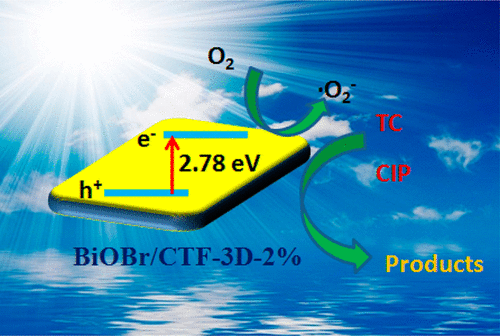当前位置:
X-MOL 学术
›
Cryst. Growth Des.
›
论文详情
Our official English website, www.x-mol.net, welcomes your feedback! (Note: you will need to create a separate account there.)
Covalent Triazine Framework Modified BiOBr Nanoflake with Enhanced Photocatalytic Activity for Antibiotic Removal
Crystal Growth & Design ( IF 3.8 ) Pub Date : 2017-12-26 00:00:00 , DOI: 10.1021/acs.cgd.7b01367 Shuai-Ru Zhu 1 , Qi Qi 1 , Yuan Fang 1 , Wen-Na Zhao 2 , Meng-Ke Wu 1 , Lei Han 1
Crystal Growth & Design ( IF 3.8 ) Pub Date : 2017-12-26 00:00:00 , DOI: 10.1021/acs.cgd.7b01367 Shuai-Ru Zhu 1 , Qi Qi 1 , Yuan Fang 1 , Wen-Na Zhao 2 , Meng-Ke Wu 1 , Lei Han 1
Affiliation

|
The development of photocatalysts based on covalent organic frameworks (COFs) is intriguing research due to their structural flexibility and tremendous catalytic sites. Herein we demonstrate a facile strategy to prepare composite materials of combined COFs and inorganic semiconductors with enhanced photocatalytic performances. A new composite photocatalyst (BiOBr/CTF-3D) integrated three-dimensional (3D) covalent triazine framework (CTF-3D) with two-dimensional BiOBr nanoflake was prepared via a simple coprecipitation method. The structural characterizations demonstrated that the amorphous CTF-3D was well modified on the surfaces of BiOBr. The photocatalytic activity of the BiOBr/CTF-3D composite was evaluated by the degradation of colorless antibiotic agents, tetracycline hydrochloride (TC) and ciprofloxacin (CIP), under visible light irradiation. When the mass percent of CTF-3D was 2%, the BiOBr/CTF-3D composite displayed the highest photocatalytic activity. The enhancement of photocatalytic performance was mainly derived from the enlarged optical adsorption range, the efficiently separated photogenerated electron–hole pairs, and the accelerated adsorption and transfer of antibiotic molecules, in the synergistically facilitating photocatalytic process. In addition, a possible photocatalytic mechanism for degrading TC by BiOBr/CTF-3D-2% was tentatively proposed. This work opens up a new strategy to improve the photocatalytic activity of traditional inorganic photocatalysts by modification with COFs materials for solving the pollution of living ecosystems.
中文翻译:

共价三嗪骨架修饰的BiOBr纳米片具有增强的光催化活性,可去除抗生素。
基于共价有机骨架(COF)的光催化剂的开发由于其结构的灵活性和巨大的催化位点而引起了人们的兴趣。在本文中,我们展示了一种简便的策略来制备具有增强的光催化性能的复合COF和无机半导体的复合材料。通过一种简单的共沉淀方法,制备了一种新型的复合光催化剂(BiOBr / CTF-3D)与三维BiOBr纳米片结合了三维(3D)共价三嗪骨架(CTF-3D)。结构表征表明,无定形的CTF-3D在BiOBr的表面上得到了很好的修饰。BiOBr / CTF-3D复合材料的光催化活性是通过在可见光照射下降解无色抗生素,四环素盐酸盐(TC)和环丙沙星(CIP)来评估的。当CTF-3D的质量百分比为2%时,BiOBr / CTF-3D复合材料表现出最高的光催化活性。在协同促进光催化过程中,光催化性能的提高主要来自扩大的光吸附范围,有效分离的光生电子-空穴对以及抗生素分子的加速吸附和转移。此外,初步提出了一种可能的光催化机理,用于通过BiOBr / CTF-3D-2%降解TC。这项工作开辟了一种新的策略,可以通过用COFs材料进行改性来改善传统的无机光催化剂的光催化活性,从而解决对生命生态系统的污染。在协同促进光催化过程中,光催化性能的提高主要来自扩大的光吸附范围,有效分离的光生电子-空穴对以及抗生素分子的加速吸附和转移。此外,初步提出了一种可能的光催化机理,用于通过BiOBr / CTF-3D-2%降解TC。这项工作开辟了一种新的策略,可以通过用COFs材料进行改性来改善传统的无机光催化剂的光催化活性,从而解决对生命生态系统的污染。在协同促进光催化过程中,光催化性能的增强主要来自扩大的光学吸附范围,有效分离的光生电子-空穴对以及抗生素分子的加速吸附和转移。此外,初步提出了一种可能的光催化机理,用于通过BiOBr / CTF-3D-2%降解TC。这项工作开辟了一种新的策略,可以通过用COFs材料进行改性来改善传统的无机光催化剂的光催化活性,从而解决对生命生态系统的污染。在协同促进光催化过程中。此外,初步提出了一种可能的光催化机理,用于通过BiOBr / CTF-3D-2%降解TC。这项工作开辟了一种新的策略,可以通过用COFs材料进行改性来改善传统的无机光催化剂的光催化活性,从而解决对生命生态系统的污染。在协同促进光催化过程中。此外,初步提出了一种可能的光催化机理,用于通过BiOBr / CTF-3D-2%降解TC。这项工作开辟了一种新的策略,可以通过用COFs材料进行改性来改善传统的无机光催化剂的光催化活性,从而解决对生命生态系统的污染。
更新日期:2017-12-26
中文翻译:

共价三嗪骨架修饰的BiOBr纳米片具有增强的光催化活性,可去除抗生素。
基于共价有机骨架(COF)的光催化剂的开发由于其结构的灵活性和巨大的催化位点而引起了人们的兴趣。在本文中,我们展示了一种简便的策略来制备具有增强的光催化性能的复合COF和无机半导体的复合材料。通过一种简单的共沉淀方法,制备了一种新型的复合光催化剂(BiOBr / CTF-3D)与三维BiOBr纳米片结合了三维(3D)共价三嗪骨架(CTF-3D)。结构表征表明,无定形的CTF-3D在BiOBr的表面上得到了很好的修饰。BiOBr / CTF-3D复合材料的光催化活性是通过在可见光照射下降解无色抗生素,四环素盐酸盐(TC)和环丙沙星(CIP)来评估的。当CTF-3D的质量百分比为2%时,BiOBr / CTF-3D复合材料表现出最高的光催化活性。在协同促进光催化过程中,光催化性能的提高主要来自扩大的光吸附范围,有效分离的光生电子-空穴对以及抗生素分子的加速吸附和转移。此外,初步提出了一种可能的光催化机理,用于通过BiOBr / CTF-3D-2%降解TC。这项工作开辟了一种新的策略,可以通过用COFs材料进行改性来改善传统的无机光催化剂的光催化活性,从而解决对生命生态系统的污染。在协同促进光催化过程中,光催化性能的提高主要来自扩大的光吸附范围,有效分离的光生电子-空穴对以及抗生素分子的加速吸附和转移。此外,初步提出了一种可能的光催化机理,用于通过BiOBr / CTF-3D-2%降解TC。这项工作开辟了一种新的策略,可以通过用COFs材料进行改性来改善传统的无机光催化剂的光催化活性,从而解决对生命生态系统的污染。在协同促进光催化过程中,光催化性能的增强主要来自扩大的光学吸附范围,有效分离的光生电子-空穴对以及抗生素分子的加速吸附和转移。此外,初步提出了一种可能的光催化机理,用于通过BiOBr / CTF-3D-2%降解TC。这项工作开辟了一种新的策略,可以通过用COFs材料进行改性来改善传统的无机光催化剂的光催化活性,从而解决对生命生态系统的污染。在协同促进光催化过程中。此外,初步提出了一种可能的光催化机理,用于通过BiOBr / CTF-3D-2%降解TC。这项工作开辟了一种新的策略,可以通过用COFs材料进行改性来改善传统的无机光催化剂的光催化活性,从而解决对生命生态系统的污染。在协同促进光催化过程中。此外,初步提出了一种可能的光催化机理,用于通过BiOBr / CTF-3D-2%降解TC。这项工作开辟了一种新的策略,可以通过用COFs材料进行改性来改善传统的无机光催化剂的光催化活性,从而解决对生命生态系统的污染。


























 京公网安备 11010802027423号
京公网安备 11010802027423号